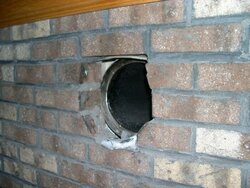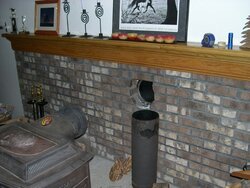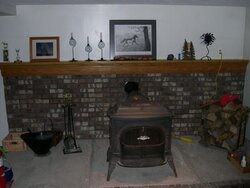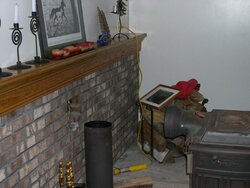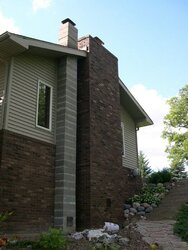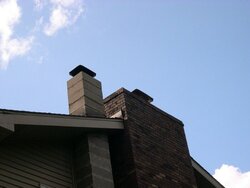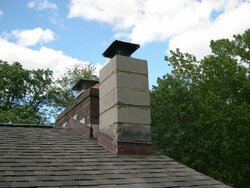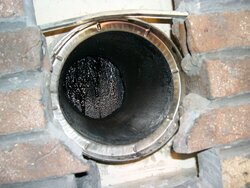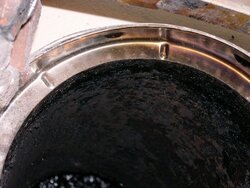First time poster, and have been looking around here a lot the past week. Any thoughts you may have on this will be appreciated.
Have an old Vermont Casting Vigilant (says 1977 on the cast iron inside the firebox in large characters). Have been using it for supplemental heat in the rec room the ten years we've been here (stove came with the house). Rec room is on the lower level near a stairwell, and house has an open floorplan upstairs, so the stove contributes significantly to household heating.
Amazingly, I used a new (though very experienced) chimney sweep this year, and he said our chimney was unsafe to use. From looking and reading here and elsewhere, he seems to be right. Took the wind out of my sails, as I work from home, and I would typically light the stove every night. We eat dinner in front of the tube in that room all the time when I'm not out of town.
The stove sits on a concrete pad with a brick wall behind it, that goes up ~2/3 of the wall height. Wood mantle over the top, the trim of which gets to around 6" from the single wall stovepipe where it enters the brick wall. Flush with the back of the brick veneer is a double wall stove pipe or chimney section (18" long) that goes through:
1. a six inch interior wallspace with minimum 2-3" clearance from drywall. Previous owner must've thought drywall to be noncombustible, so no studs are visible.
2. exterior block wall
3. small air gap (~1/4") between the block wall and the outer masonry of the chimney.
4. Chimney masonry.
5. Ceramic flue liner, ~ 7 x 12". By feel, the double wall stove pipe seems to be nicely seated/ mortared into the flue.
The 8" single wall off the Vigilant was seated into the double wall pipe by being nested inside the pipe at both the stove and double wall ends. This gives about a 4' horizontal pipe section straight back into the flue. The chimney has a total height of 23.5 feet (I added two blocks and flue liner after we moved in, chimney was too short before to meet code). Perhaps that should've been a clue...
The sweep started out suggesting a liner would be a good (but probably too expensive) idea, as we tend to get a fair bit of creosote buildup every year. After we disconnected the single from the double wall pipe in the house, though, he said we needed a proper thimble and clearances, and said the chimney was unsafe to use. He said a new thimble would be the minimum course of action, but would only quote liner + thimble (otherwise too small a job for him during his peak/busy time).
After lots of reading and looking at the situation, I'm tending to think that while the current setup may not seem particularly dangerous, it is also not correct. At the least, wood trim 6" from single-wall pipe is no good. Fires are one of those low probability & high consequence events I'd rather avoid. (And better chance of a fire here than winning the lottery, I'd venture).
I thought about using double-wall pipe through the brick veneer, but that would seem questionable at best with what's going on inside the wall (gets into the 'is drywall combustible' discussion). It would also require expanding the opening in the veneer to accommodate the pipe, so it would seem best to at least install a thimble. As the double wall pipe is nicely seated in the flue, I'm thinking I don't want to mess with what's working here.
This leads me to think that the DIY course of action would be something like this:
1. Install an Insul-Flue or Saf-T-Thimble around the existing 8" double wall pipe through the brick veneer in the house.
2. Attach a short section of double wall pipe to the existing to get beyond the brick veneer face.
3. Continue with double-wall pipe to the stove.
4. Rebuild everything back up (some brick and lintel).
5. Voila! Minimum acceptable condition.
Better would be to install a liner, but I'm thinking that would best wait for a newer stove with a smaller diameter exhaust. The sweep recommended taking out the existing clay liner in favor of 8" round stainless steel, but that seems excessive to me. And I'm also thinking a 6" liner could readily be installed through my propo0sed DIY setup when the time comes. Alternately, I could consider a squarish liner to avoid having to take out the ceramic liner (better safety factor to me).
And although I'd rather not spend way too much money, another option would be to buy a new stove and have the local shop rework the thimble and liner to be up to code (all in sync at once). Although the qualified chimney folks in this area seem to be quite busy, the shop probably has some folks lined up. So, good chance they could beat me to a better finish here. I'll probably call them tomorrow and bring it up. Even if we can afford it, though, the eventual payback on a house in Michigan makes DIY look more attractive.
Again, any thoughts on all of this appreciated. And if you've read this far I appreciate your patience...
Thanks,
John
Have an old Vermont Casting Vigilant (says 1977 on the cast iron inside the firebox in large characters). Have been using it for supplemental heat in the rec room the ten years we've been here (stove came with the house). Rec room is on the lower level near a stairwell, and house has an open floorplan upstairs, so the stove contributes significantly to household heating.
Amazingly, I used a new (though very experienced) chimney sweep this year, and he said our chimney was unsafe to use. From looking and reading here and elsewhere, he seems to be right. Took the wind out of my sails, as I work from home, and I would typically light the stove every night. We eat dinner in front of the tube in that room all the time when I'm not out of town.
The stove sits on a concrete pad with a brick wall behind it, that goes up ~2/3 of the wall height. Wood mantle over the top, the trim of which gets to around 6" from the single wall stovepipe where it enters the brick wall. Flush with the back of the brick veneer is a double wall stove pipe or chimney section (18" long) that goes through:
1. a six inch interior wallspace with minimum 2-3" clearance from drywall. Previous owner must've thought drywall to be noncombustible, so no studs are visible.
2. exterior block wall
3. small air gap (~1/4") between the block wall and the outer masonry of the chimney.
4. Chimney masonry.
5. Ceramic flue liner, ~ 7 x 12". By feel, the double wall stove pipe seems to be nicely seated/ mortared into the flue.
The 8" single wall off the Vigilant was seated into the double wall pipe by being nested inside the pipe at both the stove and double wall ends. This gives about a 4' horizontal pipe section straight back into the flue. The chimney has a total height of 23.5 feet (I added two blocks and flue liner after we moved in, chimney was too short before to meet code). Perhaps that should've been a clue...
The sweep started out suggesting a liner would be a good (but probably too expensive) idea, as we tend to get a fair bit of creosote buildup every year. After we disconnected the single from the double wall pipe in the house, though, he said we needed a proper thimble and clearances, and said the chimney was unsafe to use. He said a new thimble would be the minimum course of action, but would only quote liner + thimble (otherwise too small a job for him during his peak/busy time).
After lots of reading and looking at the situation, I'm tending to think that while the current setup may not seem particularly dangerous, it is also not correct. At the least, wood trim 6" from single-wall pipe is no good. Fires are one of those low probability & high consequence events I'd rather avoid. (And better chance of a fire here than winning the lottery, I'd venture).
I thought about using double-wall pipe through the brick veneer, but that would seem questionable at best with what's going on inside the wall (gets into the 'is drywall combustible' discussion). It would also require expanding the opening in the veneer to accommodate the pipe, so it would seem best to at least install a thimble. As the double wall pipe is nicely seated in the flue, I'm thinking I don't want to mess with what's working here.
This leads me to think that the DIY course of action would be something like this:
1. Install an Insul-Flue or Saf-T-Thimble around the existing 8" double wall pipe through the brick veneer in the house.
2. Attach a short section of double wall pipe to the existing to get beyond the brick veneer face.
3. Continue with double-wall pipe to the stove.
4. Rebuild everything back up (some brick and lintel).
5. Voila! Minimum acceptable condition.
Better would be to install a liner, but I'm thinking that would best wait for a newer stove with a smaller diameter exhaust. The sweep recommended taking out the existing clay liner in favor of 8" round stainless steel, but that seems excessive to me. And I'm also thinking a 6" liner could readily be installed through my propo0sed DIY setup when the time comes. Alternately, I could consider a squarish liner to avoid having to take out the ceramic liner (better safety factor to me).
And although I'd rather not spend way too much money, another option would be to buy a new stove and have the local shop rework the thimble and liner to be up to code (all in sync at once). Although the qualified chimney folks in this area seem to be quite busy, the shop probably has some folks lined up. So, good chance they could beat me to a better finish here. I'll probably call them tomorrow and bring it up. Even if we can afford it, though, the eventual payback on a house in Michigan makes DIY look more attractive.
Again, any thoughts on all of this appreciated. And if you've read this far I appreciate your patience...
Thanks,
John


